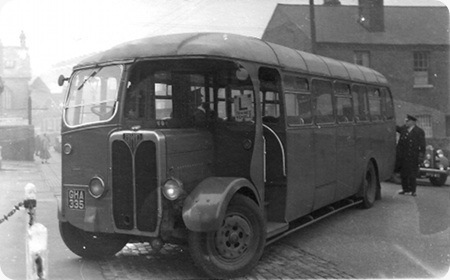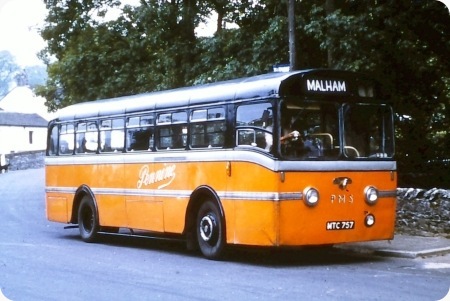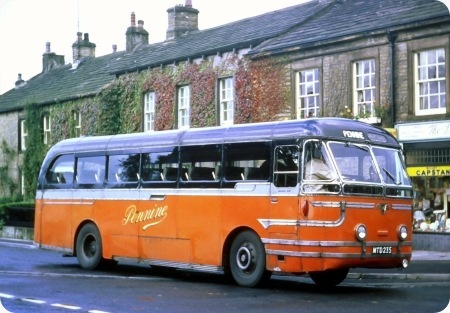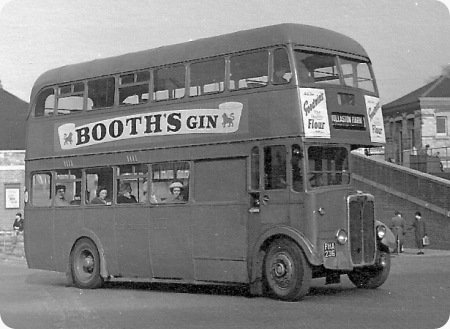Midland Red – SOS SON – GHA 335 – 2416

Photograph by ‘unknown’ if you took this photo please go to the copyright page.
Midland Red (Birmingham & Midland Motor Omnibus Co)
1940
SOS SON
Brush B38F
Another image by an unknown photographer. It shows Midland Red 2416 (GHA 335), a SOS SON of 1940. Apparently seen in its final days – acting as a "Trainee Vehicle" – it still exudes an air of quaint gentility in spite of it having been rebuilt in the late 1940s. (It makes an interesting comparison with the other picture of a SON of this site in its wartime condition).
This view seems to show the driver under reversing supervision at an unknown location (help required please).
Its sister, 2418, is preserved as part of the Wythall collection.
Photograph and Copy contributed by Paul Haywood
03/10/12 – 06:19
Why is it that, every time I see one of these radiators, I think "AEC"? Maybe it’s because I’m a Londoner by birth, despite the Lancashire origins!
Pete Davies
03/10/12 – 09:56
An amusing observation, Pete, that all readers will understand. I looked at the photo, as I did at the earlier one, and wondered about the destination display. The lack of information might be explicable because the vehicle is on driver training, and the similar lack of display on the other SON might (just) be explicable in terms of wartime conditions. However, why is there no destination box at all? The roof line seems to be begging for one. What was Midland Red’s practice?
Roy Burke
03/10/12 – 17:54
Roy, did it perhaps come from the era of slipboards mounted diagonally across the bonnet?
Stephen Ford
03/10/12 – 17:55
If you look at the other wartime SOS-in-service on this site, all is revealed about the destination boards (I had to look first)…. but it still looks as if they meant to have a proper box and changed their minds!
Joe
03/10/12 – 17:55
Yes, Roy, this lack of destination screen has always puzzled me. None of the MR half-cabs had them but, as we can see, the body seems to have been designed for a very shallow one. All these buses used destination boards, positioned in slots more or less where the "L" plate is, even after they were rebuilt in the late 1940s. When we consider that, by this time, MR were one of the most progressive operators in the UK – we have to wonder why they retained this archaic arrangement.
Paul Haywood
04/10/12 – 07:33
Not just the destination arrangement but the vehicle itself looks archaic. The last operator to buy SOS chassis from MR was Trent who took their last ones in 1940. Throughout the thirties, most of the Trent ones were antiquated looking. No doubt they were sturdy, no doubt they were economical, but when compared to their neighbours, East Midland and Barton with their impressive fleets of Leylands, I’ve always thought they must have been something of a joke.
Chris Barker
06/10/12 – 07:45
I agree with Chris that Midland Red’s in house SOS designs always looked archaic in comparison with contemporary competition, and the 1920s shape of radiator that, until 1937/38, preceded the "AEC clone" type shown above made the machines look even more ancient. The destination display matter is intriguing. By 1929, the Midland Red fleet consisted entirely of single deck vehicles, and to cope with increasing passenger loadings, the company introduced its first double deck design in 1931, subsequently producing fifty in 1932/33. This design, the DD-RE (I am given to understand that the often quoted designation REDD is erroneous) had a conventional destination display at the front between the decks, yet new single deckers continued to appear with the slip board arrangement on the bulkhead behind the engine bonnet. Someone at the top of the company must have had an intransigent attitude to persevere with this system for so long.
Roger Cox
09/10/12 – 08:19
In connection with Midland Red destination boards on SON vehicles, I remember that about 1950, there used to be an open box in Leominster Bus Station in which appropriate ones were stored for use as required. Nowadays, such an arrangement would provide a ready supply of offensive weapons!
Service numbers were displayed using stencils in a back-lit box in the front nearside window. Only two stencils of each figure were carried, hence there were no BMMO routes numbered 111, 222, 333 etc.
John Hodkinson
15/10/12 – 07:53
BMMO were in the forefront of advertising their services – although it seems Donald Sinclair didn’t necessarily approve of O.C. Power’s tastes in such matters. So why the blinking heck didn’t they see fit to actually advertise clearly where each bus was actually going? – dark night, fog . . . stencil and wooden board??
Philip Rushworth
29/01/13 – 06:30
The location is Rutland Road, Bearwood. Training Instructor Grainger is watching an obviously trustworthy trainee reverse out of the back entrance to the garage, adjacent to the training school – presumably the route through the garage was blocked.
Mr Grainger took me for my driving assessment when I joined the Midland Red in 1973, which I passed with colours if not flying, then certainly flapping in the breeze!
Lloyd Penfold
29/01/13 – 10:04
Lloyd – how good to get not only the exact location, but a name as well! Thank you. The photo has a late 1950s feel to it, so Instructor Grainger would still have at least a decade of active service left. It’s amazing to think that, presumably, he would have had to be proficient in driving these arcane specimens and the C5 motorway expresses!
Paul Haywood
29/01/13 – 15:24
LLoyd, funny how a name triggers the memory (now at 78 suffering somewhat). Mr Grainger took me in Fedd BHA 453 on 13th March ’57 – I kept the record of my training from 11th-28th March 1957 – and again on my ‘pre-test accessment’ on 28th then passed me to Mr Gowan and D7 4453 (XHA 453) for the test, passed OK. Wonder if you recall any of the other instructors : Messrs Shanain, Skinner, Yardley, Callaghan, Powell, Bennett, Mynard and Birch? It was a short but happy training month as I recall.
Nigel Edwards
22/03/14 – 08:26
Midland Red managed without illuminated destination indicators because it was a system where each route was so well known and each stop so clearly marked that it was hard to get the wrong bus by mistake:if in doubt you simply asked the conductor! I was about 12 when the last SONs were in service and I clearly remember that the vehicle batteries could just cope with starting the engine, the interior lights went right out and often had to be switched off in order to start! I doubt if the system could have coped with more lights! Remember that visibility was not exactly a priority in those days, when only a dim red stop/tail light was provided, and this was in a partly rural area. The departure stops were carefully worked out,to the extent that certain stops on a road were used by certain services only. There was one Stop I used near my home in town, which was provided for just the one cross-town route only… other services along that road, and there were many, just ignored it! A couple of my family worked on the buses in that era and never had a problem with destination boards: you just carried the ones you needed on that shift, not a full set!
Michael F
20/04/15 – 07:03
Another idiosyncratic point about SOS half-cabs was the way that the radiator was always offset to the nearside of the centre line of the vehicle by various amounts – particularly noticeable on the three FEDDs that had been given the ‘full frontal’ treatment while retaining the exposed radiator! (EHA 290 / 292 / 297)
Larry B
20/04/15 – 09:25
Larry, sorry to disagree but the SOS radiator was on the centre line, the optical illusion is due to the half cab being really a third of the width of the vehicle. The lack of a balancing mudguard on the offside adds to the illusion. As far as the FEDDs are concerned, from memory, the same illusion existed. BMMO cabs of the period were renowned for being cramped and it has been said elsewhere that the SOS/FEDDs were not the company’s finest products.
Phil Blinkhorn
21/04/15 – 06:23
Phil, the earlier SOS types with the rectangular radiator certainly had the radiator offset to the nearside whilst keeping the starting handle on the centre line. The picture of an ON at this link illustrates the point well:- www.flickr.com/photos/8755708 Midland Red seemed to take a perverse delight in the jarring aesthetics of its pre war designs. As you state, the cab tapered sharply towards the front of the vehicle to line up with the radiator offside, and the mudguards (one could scarcely call them ‘wings’ on such an ugly duckling) were different on each side. Whatever their mechanical virtues, these machines looked awful and the tedious overall red livery just compounded the problem.
Roger Cox
21/04/15 – 09:42
Roger’s link well illustrates the early production offset radiator but my point was regarding the bulk of SOS production, including the illustration on this thread. Larry stated that the radiator was always offset and this myth is perpetuated by many enthusiasts looking at photos because the optical illusion caused by the eccentric design of the cab, dash panel and mudguards misleads the eye.
Measurement of this thread’s and many other photos clearly shows that the vertical chrome strip in the centre of the radiator is at the centre of the width of the vehicle.
Phil Blinkhorn
22/04/15 – 07:25
Phil That is interesting because the starting handle aperture on the original photo at the top is not on the centre line of the radiator. Does that mean that the engine wasn’t on the centreline?
John Lomas
22/04/15 – 07:26
Phil, take a look at this frontal view of a FEDD with the later centre strip radiator. The middle point of the vehicle is surely the starting handle hole, with the radiator offset right up against the nearside dumb iron. //www.classictransportpictures.co.uk/photo_9863080.html
Roger Cox
22/04/15 – 07:26
Sorry Phil but I’m not convinced. If you look at the radiator position in relation to the spring dumb irons (which unarguably are symmetrical) the rad is closer to the near side spring than the offside.
Andrew Charles
 Vehicle reminder shot for this posting
Vehicle reminder shot for this posting
23/04/15 – 07:05
I have looked at Roger’s link image of the FEDD, and I traced a line down from the upper deck window centre strut, as this seemed to be fitted centrally. This links up nicely with the starting handle hole, and shows that the radiator centre strip is clearly off-set to the near side. My understanding from reading years ago was that most if not all SOS forward control vehicles had a narrow cab, but eased the driver’s position a little by having the engine (and therefore the radiator) mounted towards the nearside. Wasn’t the pre-war Dennis Lancet similarly constructed, with an engine and radiator to the nearside?
Michael Hampton
23/04/15 – 07:06
To me, the centre line of the FEDD radiator agrees entirely with the pillar between the two front windows upstairs, which appears to be in the centre of the body. The cab is certainly less that half the width of the body, which rather distorts the balance of the lower deck. It looks as if the springs are not equidistant from the centre line.
Chris Hebbron
23/04/15 – 07:08
The only pre-war SOS buses with a centrally mounted radiator were the OLR class, which were coaches converted during the war to half-cab from full bonneted normal control, which is why the radiator was fitted centrally.
Tony Gallimore
23/04/15 – 07:08
Roger, Andrew and John, please measure the distances between the centre line of the radiator and the extremities of the vehicles, nearside and offside in both the photo on this thread an the FEDD photo.
As for the position of the starting handle hole there are many examples of Leyland prewar single and double deckers where the starting handle hole is offset yet no-one seems to say the radiators are also off set.
Phil Blinkhorn
24/04/15 – 06:30
Phil It was because of your insistence that the rad is central that I raised the question of the engine being offset.
Ford definitely offset the engine from the centreline on the 83e vans(away from the driver, they even had 2 holes as standard to allow for LH and RH drive) Morris also had an offset engine in a van of comparable size to the Ford.
John Lomas
24/04/15 – 06:32
Sorry, Chris H, but I don’t buy the idea that the position of the offside front chassis member and spring was further outboard than its nearside equivalent. The handling consequences would have been rather "interesting", unless one was driving, of course. This picture proves the point, I think:- www.sct61.org.uk/ttrc3333
Phil, I concede that the starting handle isn’t centrally placed on the chassis, but I maintain that the radiator is offset to the nearside. If you check the dumb iron positions on the FEDD picture, they are definitely equidistant from the vehicle sides. It’s the radiator that’s askew.
Roger Cox
24/04/15 – 06:34
I accept the challenge and think I’ve found the perfect photo to illustrate the point.
In the TPC book ‘Midland Red’ Vol 1, page 126, is a photo of full front FEDD EHA 290, the radiator’s central filler cap is clearly to the nearside of the central windscreen pillar and the accompanying text states "….showing the radiator offset to the nearside."
There are a number of reasonable quality front end photos of both double and single deck models which highlight that the rad is mounted closer to the nearside front spring than the offside unit, the significance being that the springs are symmetrical to the centre line of the chassis.
Andrew Charles
Quick links to the - Comments Page - Contact Page - Home Page





